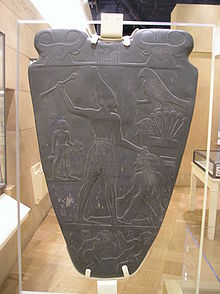Réplica

Una réplica es una obra artística que reproduce la original con exactitud. Las réplicas se utilizan con propósitos didácticos en los museos para reemplazar obras que por su fragilidad, posible deterioro u otras razones, no pueden ser expuestas. Las réplicas ofrecen una gran oportunidad para difundir el arte, acercando al público copias idénticas a las originales, obras que por diversas razones están reservadas a un círculo reducido de especialistas. Para la elaboración de las réplicas se recurre a expertos de diferentes especialidades, y se utilizan complejas tecnologías, como los rayos X, el láser o la informática.
Réplicas ilegales
[editar]
Las réplicas ilegales se denominan falsificaciones y se realizan con fines lucrativos; hay réplicas ilegales de obras de arte, especialmente a partir del siglo XX, como las de Picasso o Matisse. Las falsificaciones de billetes, monedas o documentos oficiales, de las que hay evidencias históricas desde el siglo XII en China, son también otro tipo de falsificaciones.
Las réplicas, falsificaciones, imitaciones o copias ilegales en sus diferentes acepciones se han dejado de elaborar de manera artesanal para pasar a una producción industrial, más acorde con la sociedad de consumo: imitaciones de relojes, zapatillas, o cualquier otro complemento de marcas de lujo son los artículos más demandados y copiados.
Véase también
[editar]Referencias
[editar]- Dickey, T. M. (2014). ''Understanding Replica Art: The Pursuit of Excellence in Reproduction.'' University of California Press. ISBN 978-0-520-28087-6.
- Ernst, E. (2004). ''Forgery and replica of works of art: cultural, economic, and ethical considerations.'' Journal of Applied Philosophy, 21(2), 123-137. DOI: 10.1111/j.0264-3758.2004.00257.x.
- Radcliffe, A. (2001). ''The aesthetics of forgery.'' British Journal of Aesthetics, 41(4), 353-361. DOI: 10.1093/bjaesthetics/41.4.353.
- Spivey, N. J. (1997). ''Understanding Greek Sculpture: Ancient Meanings, Modern Readings.'' Thames & Hudson. ISBN 978-0-500-23765-4.
- Thompson, D. V., & Haytko, D. L. (1997). ''Speaking of fashion: Consumers' uses of fashion discourses and the appropriation of countervailing cultural meanings.'' Journal of Consumer Research, 24(1), 15-42. DOI: 10.1086/209495.
Text is available under the CC BY-SA 4.0 license; additional terms may apply.
Images, videos and audio are available under their respective licenses.
